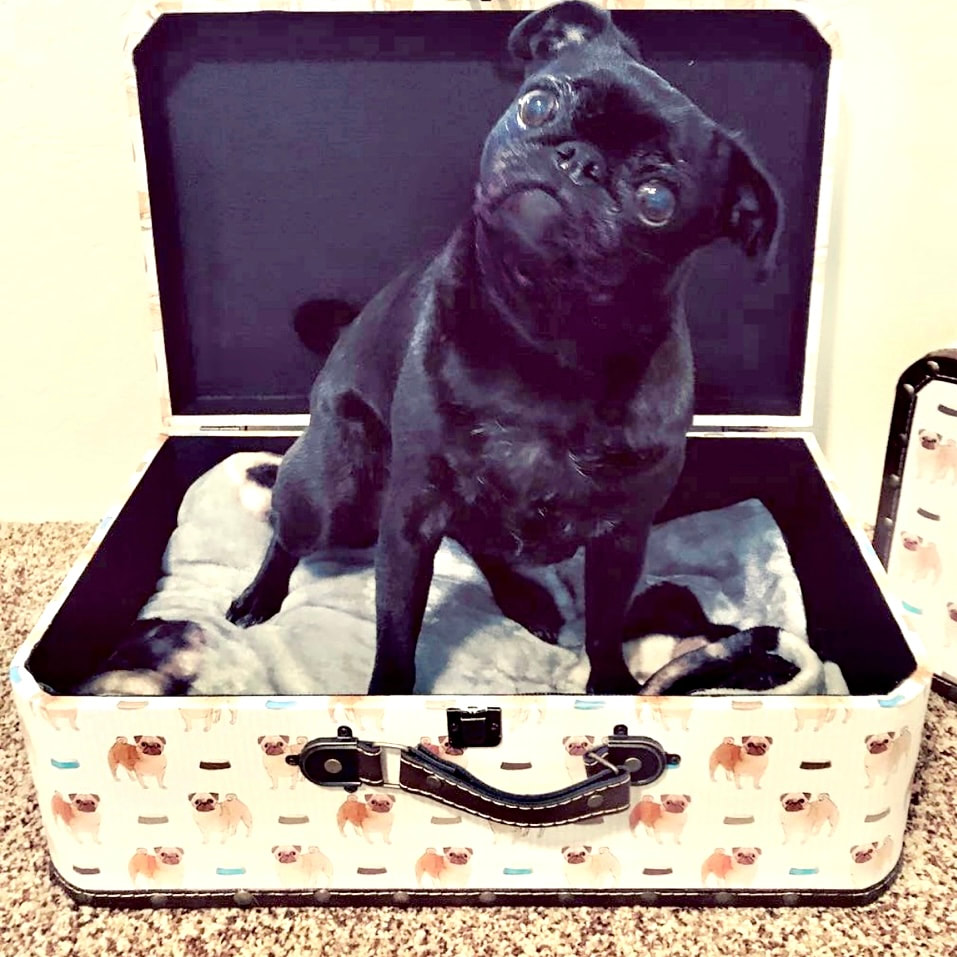|
By Katy Cable-TWR A 3 minute Read Memorial Day Weekend is coming up and that marks the kick-off to summer. Most of us are excited to get out and do some TRAVELING! If you have a dog, you're likely debating whether or not to include them on the trip or leave them behind. It's funny, when I was growing up, unless you were going camping or to the family cabin, the idea of taking your dog on a vacation, was unheard of. Especially a trip involving air travel and hotels. Well, now it's quite common. In fact, more than half of all US pet owners (59%) and just under half (41%) of travelers in the U.K. Include their pets in their vacation plans.+ However, it's very important to know your pet and be realistic about taking them on a vacation. While it's a fun getaway for you, it's a whole new, and possibly frightening, stressful, situation for many of them. Dogs thrive on a structured, consistent, routine and a vacation will be anything but. Make sure bringing your pet isn't more for your enjoyment than theirs. It may cause more anxiety than it's worth, thereby ruining what otherwise could've been a good time. On the other hand, with proper planning and some extra effort, you and your pet could share new adventures and memories to last a lifetime. If you've chosen to take your dog, prior to racing out the door, I recommend doing these helpful things. Whether you're traveling by plane, train, boat, RV or auto, being prepared and planning is key. First up, this is a great time to locate emergency pet clinics and other pet resources both at your destination and along the way. Double check your accommodation's and airline's rules on pets. Locate the pet rest areas along your route and in airports. Finally, just like you will be packing your bags, you need to pack all the essentials for your fur baby as well. You'll want to bring:
Traveling By Car:🚘 While it may be tempting to hop in the car, roll down the windows and let your pup ride shotgun, this is highly dangerous. The only thing worse than letting your dog hang their head out the window and let their ears flap in the breeze, would be to allow them to travel loose in the back of a pick-up truck. In the event of an accident, an unrestrained pet is at serious risk of injury. Pet Car Safety 101: Proper Restraint You wouldn't allow your children to ride in a vehicle unrestrained, and you shouldn't allow your pet to do so either. In the car, I recommend keeping your dog in a crate, as it is by far the safest method. That being said, it's important to properly restrain the crate in your vehicle as well. Choose one with tie-down straps and a metal safety anchor. Remember that putting your pet into a crate, carrier or secure harness is for both their safety and yours. An unrestrained pet can be a very dangerous distraction while driving. I learned this the hard way with Olive. The second I got my fries from the drive-thru windows, she jumped out of her car seat and into my lap hoping to grab a bite! Thank God a one didn't fall onto the floor. She may have slid down to my foot and caused an accident. Also, while trying to calm her from all the excitement of my fries, I was preoccupied and not driving safely. Thankfully, I was in a slow moving line and I learned an important lesson without injury. In an accident, an unrestrained pet can also turn into a projectile. This can be life-threatening for both your pet and other passengers, who could be struck by them. You'll want to choose a crate or carrier that fits your pet snugly. Allow enough room for them to be comfortable but don’t allow too much excess room (which poses a risk to your pet in an accident.) Your pet should then be secured in the back seat or cargo area of the vehicle -- not the front passenger seat. (Airbags can be deadly to pets if deployed in an accident.) RV Travel With Pets🚐 More than half of all RV owners travel with pets; and it's one of the best ways to go! However, just like in a regular vehicle, your pet should be safely restrained. They should not be allowed to roam freely in the interior while it's moving. You should also be very cautious about leaving your pet in the RV while you're away. Just like in a car, temperatures can quickly soar and become deadly. Even leaving the air conditioning running is not a guarantee. It's too risky in the event of a a power failure or other emergency. If you must leave your pet alone in an RV, invest in a temperature-monitoring device. These will send a signal to your cell phone if the temperature gets too hot or cold. To be sure your dog doesn't escape, you'll also want to securely fasten a leash and collar or harness on them before heading out. A pet gate can be used as a barrier if you plan to stay in one place and leave the door open. Traveling by air: ✈️ Air travel has become such a pain! It's a major stressor for most humans, so just think what it does to dogs! Airports are often extremely loud, crowded, frantic places where tempers are short and lines are long. We know what we're in for but a dog does not. Forget the element of flying, the airport alone can completely freak out a dog long before you ever board the plane. Air travel is also very risky, (especially for brachy/flat-nosed dogs, senior dogs, dogs with medical conditions and puppies) so I don't recommend it. If you must travel by air, which is often the case, it's crucial to do your homework first. 1. Consult with your vet and confirm your pet is OK for air travel. Elderly dogs, anxious dogs, dogs with certain medical conditions and young puppies are extremely vulnerable. Also, depending on where you are traveling they may need medical paperwork with proof of immunizations and veterinary exams. 2. Always book non-stop flights and look for deals on more "pet-friendly" airlines. Try traveling during less busy, "off-peak" days/times. 3. Make sure your dog is very comfortable in their carrier before heading to the airport. Before your scheduled flight, your dog should view their carrier as a safe place. Purchase it well ahead of time and get them used to hanging out in it at home. Make sure your pet is comfortable traveling in it on car trips as well. 4. Confirm your flight 24 hours before departure to insure there hasn't been a time change or some other alteration to the itinerary. 5. Get to the airport early on so you'll have plenty of time to walk around, acclimate and exercise your dog before boarding. 6. Make sure your dog is micro-chipped AND wearing a secure collar and ID tag. Also keep a photo of your pet on your mobile device for ID purposes in the event they are lost. 7. If at all possible ONLY fly with carriers that will allow your pet to stay with you in the main cabin. There are a plethora of reasons why it's extremely dangerous to fly pets in cargo. So much so that it is prohibited for some breeds of dogs. If you have no choice but to travel with your pet in cargo be certain to: Invest in a good-quality carrier. Defective or flimsy carriers are the culprit of most the problems with escaped or injured pets during air travel. A suitable carrier will be TSA-approved, have secure, durable, metal doors (not plastic), and tight locking bolts on the side. Make sure you pack the crate with a comfy blanket and secure a water dish inside. Securely label the outside of the crate with a cable tie. Include contact information, destination, and clear photo of your pet. Even more dangerous than the cargo hold itself is what can happen to your pet before and after boarding. This is the riskiest time for a pet during air travel. Dr. Laurie S. Coger, told USA Today: "Most injuries, escapes or deaths occur on the ground … Heat stroke, injuries due to crates being dropped or broken, or other mishaps are most likely during loading and unloading … The reason many airlines restrict travel during hot or cold times is the lack of climate control while waiting to board the plane. … Tarmacs can get blazing hot or dangerously cold, putting a pet sitting in an airline crate at great risk. Some airlines have climate-controlled pet areas where pets are held until they board. Always ask what an airline's procedures are for pets that are waiting to board, and for when they are unloaded." While the pet cargo area is temperature and pressure controlled, conditions can change drastically and quickly. Often temps can fluctuate 30-50 degrees. Add that to a caged, stressed-out pet and you have a recipe for disaster. Reduce your pet's anxiety with natural remedies. Never sedate or tranquilize a pet for air travel. It's far too risky. If your dog needs to be tranquilized to fly, they really shouldn't be put through the experience. If your dog must be sedated, make sure they are with you in the cabin so you can monitor them during flight. All pets can benefit from natural calming agents to help reduce anxiety during a trip. I WILL NOT TRAVEL without out CBD. Both Olive and I down a biscuit (or 3😜!) and pass out in-flight. Everyone’s happy and nobody leaves the flight feeling drugged, dopey or intoxicated. You can also use essential oils specifically blended for pets. Apply these calming scents in their crate and travel bedding. I hope you enjoy a wonderful and safe adventure! I'd love to see your pics and hear all about it! Pugs & 😘 kisses! -Katy +AAA travel stats WESTWAYS(May 2021) |
PARTNERSHIPS
...Let’s Work Together
I love collaborating with other influencers and brands! Whether you need assistance with social media, creating an unforgettable event or want to be featured in my nationally syndicated blog, I can help. Let’s talk!


